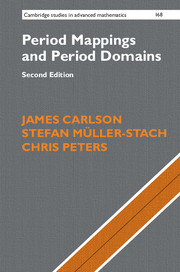Book contents
- Frontmatter
- Contents
- Preface to the Second Edition
- Preface to the First Edition
- PART ONE BASIC THEORY
- PART TWO ALGEBRAIC METHODS
- PART THREE DIFFERENTIAL GEOMETRIC METHODS
- 11 Further Differential Geometric Tools
- 12 Structure of Period Domains
- 13 Curvature Estimates and Applications
- 14 Harmonic Maps and Hodge Theory
- PART FOUR ADDITIONAL TOPICS
- Appendix A Projective Varieties and Complex Manifolds
- Appendix B Homology and Cohomology
- Appendix C Vector Bundles and Chern Classes
- Appendix D Lie Groups and Algebraic Groups
- References
- Index
13 - Curvature Estimates and Applications
from PART THREE - DIFFERENTIAL GEOMETRIC METHODS
Published online by Cambridge University Press: 30 August 2017
- Frontmatter
- Contents
- Preface to the Second Edition
- Preface to the First Edition
- PART ONE BASIC THEORY
- PART TWO ALGEBRAIC METHODS
- PART THREE DIFFERENTIAL GEOMETRIC METHODS
- 11 Further Differential Geometric Tools
- 12 Structure of Period Domains
- 13 Curvature Estimates and Applications
- 14 Harmonic Maps and Hodge Theory
- PART FOUR ADDITIONAL TOPICS
- Appendix A Projective Varieties and Complex Manifolds
- Appendix B Homology and Cohomology
- Appendix C Vector Bundles and Chern Classes
- Appendix D Lie Groups and Algebraic Groups
- References
- Index
Summary
We do two types of curvature calculation in this chapter. The first applies to variations of Hodge structures over any complex manifold and is treated in Section 13.1. As a first application, we prove that over a quasi-projective manifold, flat (parallel) sections of a variation of Hodge structure have flat (p, q)-components. This has important consequences. First, any flat section of a variation of Hodge structure over a quasi-projective manifold has flat Hodge components (theorem of the fixed part). Second, we have the rigidity theorem, which says that if we have two polarized variations of Hodge structure over a compact manifold and an isomorphism of the underlying local systems which is a morphism of Hodge structures at one point, it must be so everywhere.
More applications are in Section 13.4, first a bound on the degrees of Hodge bundles of a variation of Hodge structure over quasi-projective curves, second an application on hyperbolicity of the base curve, and finally, one on rigidity.
In order to do this, in Section 13.3 we make a digression on Higgs bundles. Among the examples we have variations of Hodge structure as well complex systems of Hodge bundles. The latter generalize variations of Hodge structure in the sense that the underlying local system may be a local system of complex vector spaces without a given real structure. Since we need base manifolds that are not necessarily compact, the technique of logarithmic extensions is needed, which is explained in the preceding Section 13.2.
Then, in Section 13.6, we do curvature calculations on the period domains and show that the sectional curvature is negative and bounded away from zero in flat directions. This implies that period maps are distance decreasing. As an application, we give in Section 13.7 Borel's proof of the monodromy theorem for a one-variable degeneration, i.e., a variation of Hodge structure over the unit disk minus a point. Geometrically, this corresponds to a family of varieties over the unit disk with smooth fibers except over the origin, which is considered to be a “degenerate” fiber, hence the term “degeneration.” This theorem gives important topological restrictions on the sort of degeneration that can appear and explains why one often assumes that the local monodromy operators of a variation of Hodge structure are quasi-unipotent or even unipotent.
- Type
- Chapter
- Information
- Period Mappings and Period Domains , pp. 346 - 382Publisher: Cambridge University PressPrint publication year: 2017



